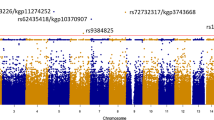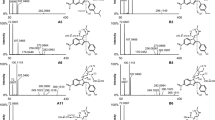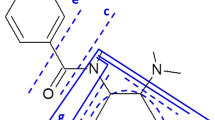Abstract
Genetic polymorphisms in cytochrome P 450 (CYP) enzymes could lead to a phenotype with altered enzyme activity. In pharmacotherapy, genotype-based dose recommendations achieved great importance for several drugs. In our pilot study, we ask if these genetic tests should be applied to forensic problems as a matter of routine. Starting from 2004 through 2008, we screened routine cases for samples where the relation of parent compound to metabolite(s) (P/M ratio), particularly morphine to codeine ratios and diazepam to its metabolites, was noticeable or not consistent with the information provided by the defendants. We found 11 samples with conspicuous results. These were analyzed for polymorphisms of the CYP 2D6 and 2C19 genes using the Roche AmpliChip Cytochrome P450 Genotyping test. If not previously conducted, a general unknown analysis by gas chromatography/mass spectrometry (GC/MS) was additionally carried out. For CYP 2D6, we found two cases with the genotype poor metabolizer (PM), three cases with heterozygote extensive metabolizer genotype classified as an intermediate metabolizer (IM) with probably reduced enzyme activities, but no ultrarapid metabolizer genotype. For CYP 2C19, two cases were characterized as IM phenotypes, with no PM found. Once we achieved no appropriate amounts of DNA, one case was excluded after GC/MS analysis. Only in one case could the polymorphism clearly explain the changes in drug metabolism. More frequently, a drug–drug interaction was thought to have a stronger impact. Additionally, our results suggest that IM genotypes may be more relevant than previously suspected. With respect to the small number of cases in which we thought a genotyping would be helpful, we conclude that the overall relevance of toxicogenetics in forensic problems is moderate. However, in some individual cases, a genotyping may provide new insight.


Similar content being viewed by others
References
Rogers JF, Nafziger AN, Bertino JS (2002) Pharmacogenetics affects dosing, efficacy, and toxicity of cytochrome p450-metabolized drugs. Am J Med 113:746–750
Flockhart, DA (2009) Drug interactions: cytochrome P450 drug interaction table (2009, Last Updated On: January 25, 2012) Indiana University School of Medicine. At :http://medicine.iupui.edu/clinpharm/ddis/table.aspx. Accessed 15 Feb 2012
Benet LZ, Kroetz DL, Sheiner LB (1996) Pharmacogenetics. In: Hardman JG, Goodman GA, Limbirds LE (eds) Goodman and Gilman's the pharmacological basis of therapeutics, vol 9. McGraw-Hill, New York, pp 3–27
Bertilsson L, Dahl M-L, Sjöqvist F, Åberg-Wistedt A, Humble M, Johansson I, Lundqvist E, Ingelman-Sundberg M (1993) Molecular basis for rational megaprescribing in ultrarapid hydroxyltors of debrisoquine. Lancet 341:63
de Leon J, Susce M, Johnson M, Hardin M, Maw L, Shao A, Allen ACP, Chiafari FA, Hillman G, Nikoloff M (2009) DNA microarray technology in the clinical environment: the ampliChip CYP450 test for CYP2D6 and CYP2C19 genotyping. CNS Spectrums 14(1):19–34
Evans WE, Relling MV (1999) Pharmacogenomics: translating functional genomics into rational therapeutics. Science 286:487–491
Kirchheiner J, Brøsen K, Dahl M, Gram L, Kasper S, Roots I, Sjöqvist F, Spina E, Brockmöller J (2001) CYP2D6 and CYP2C19 genotype-based dose recommendations for antidepressants: a first step towards subpopulation-specific dosages. Acta Psychiatr Scand 104(3):173–193
Zaridze DG (2008) Molecular epidemiology of cancer. Biochemistry-Russia 73(5):532–542, Review
Kadlubar FF, Butler MA, Kaderlik KR, Chou H-C, Lang NP (1992) Polymorphisms for aromatic amine metabolism in humans: relevance for human carcinogenesis. Environ Heal Perspect 98:69–74
Mohamed AS, Chia S (2008) Interethnic variability of plasma paraoxonase (PON1) activity towards organophosphates and PON1 polymorphisms among Asian populations—a short review. Ind Heal 46(4):309–317, Review
Koski A, Ojanperä I, Sistonen J, Vuori E, Sajantila A (2007) A fatal doxepin poisoning associated with a defective CYP2D6 genotype. Am J Forensic Med Pathol 28(3):259–261
Sallee FR, DeVane CL, Ferrell RE (2000) Fluoxetine-related death in a child with cytochrome P-450 2D6 genetic deficiency. J Child Adolesc Psychopharmacol 10:27–34
Madadi P, Hildebrandt D, Gong I, Schwarz U, Ciszkowski C, Ross C, Sistonen J, Carleton B, Hayden M, Lauwers A, Koren G (2010) Fatal hydrocodone overdose in a child: pharmacogenetics and drug interactions. Pediatrics 126(4):e986–e989, Epub2010 Sep 2013
Gasche Y, Daali Y, Fathi M, Chiappe A, Cottini S, Dayer P, Desmeules J (2004) Codeine intoxication associated with ultrarapid CYP2D6 metabolism. N Engl J Med 351(27):2827–2831
Koren G, Cairns J, Chitayat D, Gaedigk A, Leeder S (2006) Pharmacogenetics of morphine poisoning in a breastfed neonate of a codeine-prescribed mother. Lancet 368(9536):704
Koski A, Sistonen J, Ojanperä I, Gergov M, Vuori E, Sajantila A (2006) CYP2D6 and CYP2C19 genotypes and amitriptyline metabolite ratios in a series of medicolegal autopsies. Forensic Sci Int 158:177–183
Jannetto PJ, Wong SH, Gock SB, Laleli-Sahin E, Schur BC, Jentzen JM (2002) Pharmacogenomics as molecular autopsy for postmortem forensic toxicology: genotyping cytochrome P450 2D6 for oxycodone cases. J Anal Toxicol 26:438–447
Levo A, Koski A, Ojanperä I, Vuori E, Sajantila A (2003) Post-mortem SNP analysis of CYP2D6 gene reveals correlation between genotype and opioid drug (tramadol) metabolite ratios in blood. Forensic Sci Int 135:9–15
Holmgren P, Carlsson B, Zackrisson A-L, Lindblom B, Dahl M-L, Scordo MG, Druid H, Ahlner J (2004) Enantioselective analysis of citalopram and its metabolites in postmortem blood and genotyping for CYP2D6 and CYP2C19. J Anal Toxicol 28:94–104
Zackrisson A, Holmgren P, Gladh A, Ahlner J, Lindblom B (2004) Fatal intoxication cases: cytochrome P450 2D6 and 2C19 genotype distributions. Eur J Clin Pharmacol 60(8):547–552
Druid H, Holmgren P, Carlsson B, Ahlner J (1999) Cytochrome P450 2D6 (CYP2D6) genotyping on postmortem blood as a supplementary tool for interpretation of forensic toxicological results. For Sci Int 99:25–34
Jin M, Gock SB, Jannetto PJ, Jentzen JM, Wong SH (2005) Pharmacogenomics as molecular autopsy for forensic toxicology: genotyping cytochrome P450 3A4*1B and 3A5*3 for 25 fentanyl cases. J Anal Toxicol 29:590–598
Musshoff F, Stamer U, Madea B (2010) Pharmacogenetics and forensic toxicology. Forensic Sci Int 203(1–3):53–62
Sajantila A, Palo J, Ojanpera I, Davis C, Budowle B (2010) Pharmacogenetics in medico-legal context. For Sci Int 203:44–52
Jones AW, Holmgren A, Kugelberg FC (2007) Concentrations of sheduled prescription drugs in blood of impaired drivers: considerations for interpreting the results. Ther Drug Monit 29(2):248–260
Roche, Diagnostics (2006) AmpliChip CYP450 test. Roche Molecular Systems, Inc., Branchburg, NJ 08876 USA
Daly A, Brockmöller J, Broly F, Eichelbaum M, Evans W, Gonzalez F, Huang J, Idle J, Ingelman-Sundberg M, Ishizaki T, Jacqz-Aigrain E, Meyer U, Nebert D, Steen V, Wolf C, Zanger U (1996) Nomenclature for human CYP2D6 alleles. Pharmacogenetics 6(3):193–201
Zackrisson A, Lindblim B, Ahlner J (2010) High frequency of occurrence of CYP2D6 gene duplication/multiduplication indicating ultrarapid metabolism among suicide cases. Clin Pharm Ther 88(3):354–359
Zanger U, Raimundo S, Eichelbaum M (2004) Cytochrome P450 2D6: overview and update on pharmacology, genetics, biochemistry. Naunyn Schmiedebergs Arch Pharmacol 369(1):23–37
Zhou S (2009) Polymorphism of human cytochrome P450 2D6 and its clinical significance: part I. Clin Pharmacokinet 48(11):689–723
Agúndez JAG, Ledesma MC, Ladero JM, Benítez J (1995) Prevalence of CYP2D6 gene duplication and its repercussion on the oxidative phenotype in a white population. Clin Pharmacol Ther 57(3):265–269
Meyer UA (2000) Pharmacogenetics and adverse drug reactions. Lancet 356:1667–1671
Toscano C, Klein K, Blievernicht J, Schaeffeler E, Saussele T, Raimundo S, Eichelbaum M, Schwab M, Zanger UM (2006) Impaired expression of CYP2D6 in intermediate metabolizers carrying the *41 allele caused by the intronic SNP 2988G>A: evidence for modulation of splicing events. Pharmacogenet Genomics 16:755–766
Carlsson B, Holmgren A, Ahlner J, Bengtsson F (2009) Enantioselective analysis of citalopram and escitalopram in postmortem blood together with genotyping for CYP2D6 and CYP2C19. J Anal Toxicol 33(2):65–76
Ahlner J, Zackrisson A, Lindblom B, Bertilsson L (2010) CYP2D6, serotonin and suicide. Pharmacogenomics 11(7):903–905
Kronstrand R, Jones AW (2001) Letter to the editor: concentration ratios of codeine-to-morphine in plasma after a single oral dose (100 mg) of codeine phosphate. J Anal Toxicol 25:486–487
Quiding H, Anderson P, Bondesson U, Boréus LO, Hynning P-A (1986) Plasma concentrations of codeine and its metabolite. Morphine, after single and repeated oral administration. Eur J Clin Pharmacol 30:673–677
Shah JC, Mason WD (1990) Plasma codeine and morphine concentrations after a single oral dose of codeine phosphate. J Clin Pharmacol 30:764–766
Cone EJ, Welch P, Paul BD, Mitchell JM (1991) Forensic drug testing for opiates. III. Urinary excretion rates of morphine and codeine following codeine administration. J Anal Toxicol 15:161–166
He YJ, Brockmöller J, Schmidt H, Roots I, Kirchheiner J (2008) CYP2D6 ultrarapid metabolism and morphine/codeine ratios in blood: was it codeine or heroin? J Anal Toxicol 32:178–182
Armstrong SC, Cozza KL (2003) Med-psych drug-drug interactions update—pharmacokinetic drug interactions of morphine, codeine, and their derivatives: theory and clinical reality, part II. Psychosomatics 44(6):515–520
Delgoda R, Westlake ACG (2004) Herbal interactions involving cytochrome P450 enzymes. Toxicol Rev 23(4):239–249
Bomsien S, Skopp G (2007) An in vitro approach to potential methadone metabolic-inhibition interactions. Eur J Clin Pharmacol 63(9):821–827. doi:10.1007/s00228-007-0327-z
Buchard A, Linnet K, Johansen S, Munkholm J, Fregerslev M, Morling N (2010) Postmortem blood concentrations of R- and S-enantiomers of methadone and EDDP in drug users: influence of co-medication and p-glycoprotein genotype. J Forensic Sci 55(2):457–463, Epub
Kroon L (2007) Drug interactions with smoking. Am J Health Syst Pharm 64(18):1917–1921
Skopp G (2010) Artifacts are an inherent part of postmortem toxicology. TIAFT Bulletin 40:7–17
Bock K, Schrenk D, Forster A, Griese E, Mörike K, Brockmeier D, Eichelbaum M (1994) The influence of environmental and genetic factors on CYP2D6, CYP1A2 and UDP-glucuronosyltransferases in man using sparteine, caffeine, and paracetamol as probes. Pharmacogenetics 4(4):209–218
Acknowledgments
We thank Kristin Klätschke for handling the DNA samples.
Author information
Authors and Affiliations
Corresponding author
Rights and permissions
About this article
Cite this article
Andresen, H., Augustin, C. & Streichert, T. Toxicogenetics—cytochrome P450 microarray analysis in forensic cases focusing on morphine/codeine and diazepam. Int J Legal Med 127, 395–404 (2013). https://doi.org/10.1007/s00414-012-0759-6
Received:
Accepted:
Published:
Issue Date:
DOI: https://doi.org/10.1007/s00414-012-0759-6




